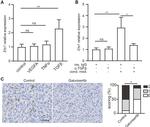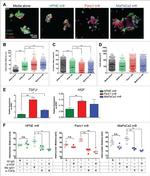Search Thermo Fisher Scientific
Invitrogen
TGF beta-1,2,3 Monoclonal Antibody (1D11.16.8), Functional Grade, eBioscience™
FIGURE: 1 / 2
TGF beta-1,2,3 Antibody (16-9243-85) in Neu


Product Details
16-9243-85
Species Reactivity
Published species
Host/Isotype
Class
Type
Clone
Conjugate
Form
Concentration
Purification
Storage buffer
Contains
Storage conditions
Shipping conditions
RRID
Product Specific Information
Description: The monoclonal antibody 1D11.16.8 recognizes human, mouse, rat, hamster, canine and non-human primate Transforming Growth Factor (TGF) beta 1, 2 and 3. TGF beta is a pleiotropic cytokine that exists as five isoforms (TGF beta 1-5) that share 70-80% homology with each other. However, these isoforms are not homologous to TGF alpha. TGF beta 1 is highly conserved between human, murine, simian, bovine, porcine, and chicken proteins. TGF beta 1 is the most abundant isoform and is ubiquitously expressed by a variety of cell types, including platelets, macrophages, lymphocytes, endothelial cells, chondrocytes, and leukemic cells. However, the other isoforms exhibit a more restricted expression pattern.
TGF beta 1 is synthesized as a long precursor polypeptide, which is cleaved to yield the mature protein and the Latency Associated Peptide (LAP). LAP and mature TGF beta 1 remain non-covalently associated during secretion, forming homodimers known as the Small Latent Complex (SLC). Secretion can be induced by steroids, retinoids, EGF, NGF, vitamin D3, and IL-1. The bioactivity of mature TGF beta 1 is dependent on its release from LAP by conformational changes and proteolytic processing. Its activities include inhibition of cell growth in epithelial cells, endothelial cells, fibroblasts, neurons, lymphoid cells, and other hematopoietic cell types. TGF beta 1 also inhibits the proliferation of T and NK cells, downregulates the activities of activated macrophages, and blocks the anti-tumor activity of IL-2 - bearing lymphokine-activated killer (LAK) cells. Recently, TGF beta 1 has been found to play a critical role in the development of regulatory T cells and act as a costimulatory factor for expression of Foxp3. Dendritic cells exposed to tumors have been reported to secrete TGF beta 1 and stimulate the differntiation of CD4+CD25+ Treg cell from peripheral CD4+CD25- progeny. TGF beta 1-induced regulatory T cells have been termed iTregs.
Applications Reported: This 1D11.16.8 antibody has been reported for use in neutralization assays both in vivo and in vitro and immunohistochemical staining of formalin-fixed paraffin embedded tissue sections.
Storage and handling: Use in a sterile environment.
Filtration: 0.2 µm post-manufacturing filtered.
Purity: Greater than 90%, as determined by SDS-PAGE.
Endotoxin Level: Less than 0.001 ng/µg antibody, as determined by LAL assay.
Aggregation: Less than 10%, as determined by HPLC.
Target Information
TGF-beta1, -2, and -3 are a closely related group of proteins (70-80% sequence homology) that are produced by many cell types and function as growth and differentiation factors. The active forms of TGF-beta1, -2, and -3 are disulfide-linked homodimers.
For Research Use Only. Not for use in diagnostic procedures. Not for resale without express authorization.
Bioinformatics
Protein Aliases: latency-associated peptide; prepro-transforming growth factor beta-1; regulatory protein; tgf beta 1; tgf beta 3; tgf beta1; TGF-beta 1; TGF-beta-1; Transforming growth factor; transforming growth factor beta-1; Transforming growth factor beta-1 proprotein; transforming growth factor, beta 1; transforming growth factor, beta 1 (Camurati-Engelmann disease); transforming growth factor, beta-1; transforming growth factor-beta 1
Gene Aliases: CED; DPD1; LAP; TGF-beta1; TGFB; Tgfb-1; TGFB1; TGFbeta; TGFbeta1
UniProt ID: (Human) P01137, (Rat) P17246, (Mouse) P04202
Entrez Gene ID: (Human) 7040, (Dog) 403998, (Rat) 59086, (Chinese hamster) 100773359, (Mouse) 21803

Performance Guarantee
If an Invitrogen™ antibody doesn't perform as described on our website or datasheet,we'll replace the product at no cost to you, or provide you with a credit for a future purchase.*
Learn more
We're here to help
Get expert recommendations for common problems or connect directly with an on staff expert for technical assistance related to applications, equipment and general product use.
Contact tech support
